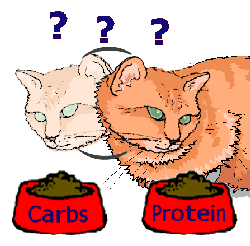Pet nutrition

You have probably seen the advertisements - 'Brand X is higher in protein! Buy protein-rich Brand X for a happier, healthier pet! Dogs/cats prefer Brand X because of its rich protein content.' But did anyone actually ask the pets?
That's what Oregon State University researchers have tried to do in a recent set of experiments. It's been shown that with humans, once our lethal fondness for fat and sugar has been taken out of the equation, people tend to eat what their bodies require.
So to find out what pets' instincts tell them about their grub, researchers created four diets of equal palatability. Though the food tasted the same, Food #1 was the advertiser's favourite - a high-protein diet. Food #2 was a high-fat diet, Food #3 offered peak carbohydrates, and Food #4 was a balanced set of nutrients. The idea was that once taste was no longer a factor, the pets would choose the food which most satisfied their metabolic needs.
Seventeen healthy dogs and 27 healthy cats were conscripted into the programme. The dogs were given an hour a day to chow down on as much food they wanted - until they had reached a predetermined calorie intake. The cats were given the buffet option, and could eat when they chose, but still only up to the daily calorie limit - at which point they had eaten all that their metabolisms required anyway. (In fact it was discovered that cats tended to eat no more than their bodies required in any case - that so many pet cats are obese is a testament to how much modern cat foods have additives which encourage cats to eat more than they need.)
After 28 days, the animals' diet preferences were examined, and guess what? Not a single dog or cat opted for a mainly protein-rich diet. The dogs went for the fat-rich food, choosing it for 41% of their calories (with a variation of plus or minus 4.3%), with most of the rest of their nutrition - 30.3% (+/- 3.9%) - being eaten as carbohydrates.
This is perhaps unsurprising as dogs evolved as highly-active animals and fat was the most readily available form of energy on offer. Cats in the wild eat a protein-rich diet of small meaty rodents, yet when offered a choice it seems their metabolisms prefer carbs. In the test 43.1% (+/- 4%) went first for the carbohydrates, and only then for the proteins 35.8% (+/- 3.9%). It turns out that the younger the cat, the more their metabolisms prefer protein. With dogs on the other hand, the younger, leaner dogs actually ate less protein than did the chubby ones.
These diet choices have consequences. Some fatty foods, such as fish oils, are rich in a long-chain omega-3 fatty acid called DHA. This is important in the proper function of the brain, heart and eyes among other essential bodily bits. While none of the food fed to the cats contained DHA, the feline metabolism creates its own by processing the fat in food into fatty acids which are absorbed into the bloodstream. Younger cats are more efficient at this, which may be why their metabolisms nudged them into eating only the lesser amount of fat that they actually needed for the process.
Protein is also broken down in the body, but in this case it produces an unwelcome side effect called sulfated microbial catabolic products. No-one has yet done definitive tests in animals, but in humans these protein by-products are associated with cardiovascular and kidney disease. Despite eating less protein, older cats had more of these by-products in their systems, which suggests again that the older cats chose to eat less protein because at a metabolic level their bodies knew they were unable to process the stuff as efficiently as they once could.
Overall, the sample of animals was too small to be definitive, but the results are in agreement with other studies among humans which shows that we tend to gravitate toward foods which our bodies reckon we need. (The 'cravings' of pregnant women are a well-known example of this.) It seems that the same is true of cats and dogs, so giving them no option but a high-protein diet may not be the best choice.
Journal Reference
Jean A. Hall, Jodi C. Vondran, Melissa A. Vanchina, Dennis E. Jewell. When fed foods with similar palatability, healthy adult dogs and cats choose different macronutrient compositions. The Journal of Experimental Biology (2018); jeb.173450 jeb.biologists.org/content/early/2018/05/16/jeb.173450
The information supplied here is intended as a guideline only.
